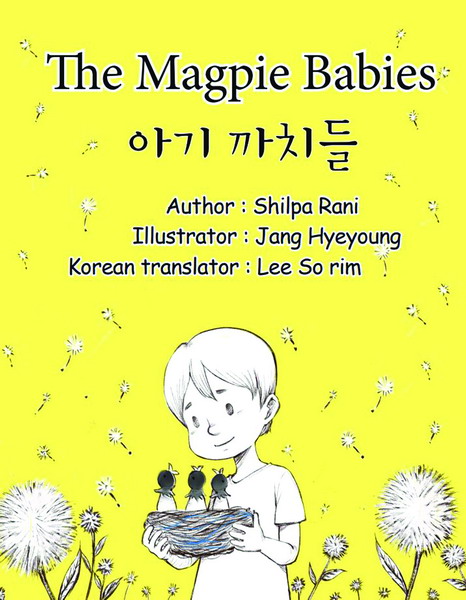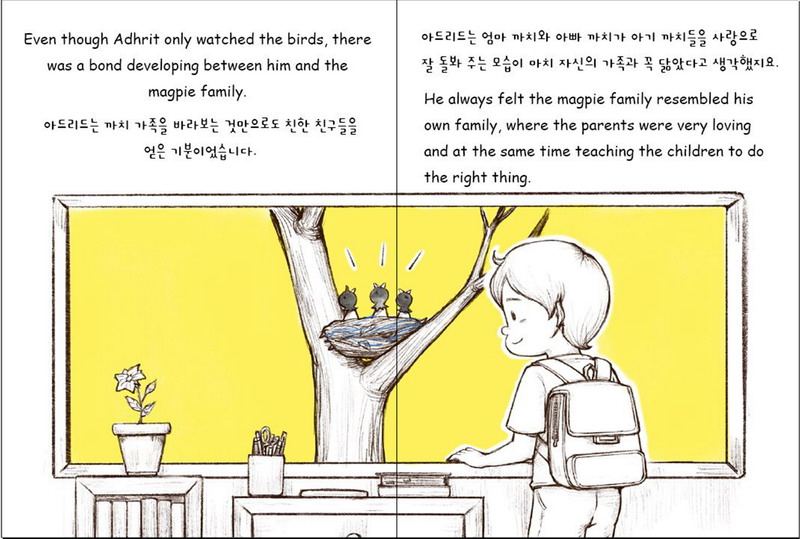The Magpie Babies: My First Children’s Book
By Shilpa Rani
I believe stories add color to our imagination. Stories are an integral part of childhood, the ones we hear, read, or make up. They make a lasting imprint on one’s memory. As a child, I made up stories to memorize mathematical tables, and as an undergrad, I made up stories to remember the lengthy pathogenesis of different diseases in animals. Now as a parent, I create stories to entertain my son. Like art, stories have the power to transform anything mundane into something extraordinary. Stories can take us across uncharted territories to mysterious worlds only a few privileged ones can travel to or give us a perspective on reality right here on earth.
As children, we have all experienced this magic: of creating stories, narrating them, and dreaming about them. But most of us forget this art as we grow older and our priorities change to chasing a career or a family or both. As a doctoral student at the Gwangju Institute of Science and Technology (GIST), I was doing just that. While my brain was trying to figure out the molecular basis for heart diseases, my heart was always looking for ways to be surrounded by books and tell stories. So, I took every opportunity to relive the magical world of stories with children. I am grateful that I have had the opportunity to volunteer to read books to children at the Children’s English Library in Gwangju, at the KONA Storybook Center, as a volunteer at the GIST library, and through storytelling programs at the GIC. I should also credit my son: He has had a major influence on bringing me back to falling in love with storytelling. These experiences gave me time to read and absorb children’s literature.

Writing a children’s book and becoming a part of someone’s childhood memories has been a dream of mine. It was not hard to find inspiration while living in Gwangju. The Magpie Babies is inspired by my observations of Oriental magpie families year after year. They would start building their nests from scratch in leafless metasequoia trees, painstakingly bringing each stick and twig to arrange them into a home. The nest would be occupied by noisy chicks in a few days, but soon in spring, the trees would sprout, obstructing our view of their beautiful world. Regardless, the chicks would grow older and leave home. This became the foundation of the story of The Magpie Babies. The story unfolds in an urban setting and shows how empathy in young children shapes their association with nature. The story also emphasizes taking responsibility and action to protect a loved one. There is a subtle effort made to create a sense of balance in the worldview of the young readers by including global cultural names for characters that are siblings and inhabit the same nest.
Once the plot was ready, the next step was to add colors to the story. An illustrator plays an integral role in a children’s book. Good communication between the author and the illustrator is essential for the illustrator to understand and envision the plot and the characters in the author’s imagination. I was very fortunate to have a dear friend working on this project with me. She was brilliant and a pleasure to brainstorm our perspectives on the visuals of the scenes with. We agreed upon using a fixed set of colors as opposed to most books in this genre.
Once the words and colors had been added to the story, it was time to put it into the hands of the readers. But the truth was, I did not know anything about publishing a book. My learning journey started from here. There is an ocean of information to research to make the decisions that best suit us. There are two ways of publishing a book, either by a traditional method through an agent and a publishing house or by self-publishing. There are several advantages and disadvantages to choosing either option. I decided to self-publish. There are several services that companies offer to assist self-publishing authors: editing, internal designing, cover page designing, etc. There are several methods for self-publishing a book as well. The path I chose to publish paperback copies of the book was through print on demand (POD). Several publishers provide this service, including Amazon KDP, Ingram, and Kyobo POD. Through this service, the book is printed and shipped only after it has been ordered online. These services have pre-defined specifications for the dimensions of the book, size, and quality of the illustrations, bleed or no bleed, and text on illustrations. One needs to be mindful of these specifications while preparing their manuscript before uploading it to any of these portals. The POD publishers also give the author a choice to either request an ISBN from the publisher or use a self-bought ISBN. Kyobo POD is the one I picked to publish my book in Korea. Broadly, most POD publishers provide similar services but have differences, too. Thorough research and understanding of terminologies used in publication helped to smooth my journey.

The story of The Magpie Babies has been told in both the Korean and English languages simultaneously. When I was learning Korean, I wanted to read less complex stories in Korean and make sure I understood the context right by confirming reading it in English. But unfortunately, there were not many books in this Korean-English format for me to choose from. Hence, while working on my children’s book, I wanted to tell the story in both languages. I hope that children learning either language will be able to relate to the story.
Self-publishing a children’s book is not the ordeal it would have been a few years ago, but like anything else, there is a learning curve. The Magpie Babies is a collection of my memories of Gwangju, where I built my nest for a short time and made wonderful friends. The Korean version of the book, 아기 까치들 (agi kkachi-deul), would not have been possible without the support of Lee Sorim and Kim Minsu. I extend my gratitude to them. The book is dedicated to all nature-loving children. I hope young readers and adults reading to young ones can relate to the story and enjoy the magic of reading books.
The Author
Shilpa Rani is a veterinarian by profession and mother of a young boy who adores nature. She pursued her doctoral and postdoctoral studies at Gwangju Institute of Science and Technology (GIST). She considers Gwangju her second home. Instagram @shilpavet





